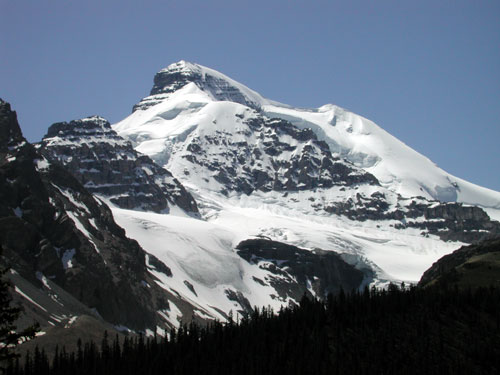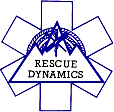This route has been popular among mountain guides as it is slightly lower Than Mt. Athabasca and can sometimes be in condition when Athabasca is not. It also has some rock shortroping and rock climbing on the summit block. It has a number of obvious and hidden dangers that will be described below. This is often one of the alternate choices for the summit day on day three of the Basic Snow and Ice Course (day five of Intro to Mountaineering). It is also a very common ascent during the Alpine Climbing course and Leadership Courses. There are at least three routes we commonly use to climb A2: If you are in the Icefields area and want something else to climb, consider one of the routes on A2. Between the three routes there is a tremendous range of difficulty. The summit is 10,000 feet / 3000 meters above sea level which means altitude sickness is more rare than on the larger peaks nearby. Fit individuals will seldom suffer from affects of altitude during our climbs here. Headaches and feeling unduly tired are commonly the result of poor hydration, not sleeping well the previous night, not eating enough or simply poor fitness. Keeping hydrated and fed along with proper pacing and well spaced breaks are some ways to compensate for dehydration, altitude and lower fitness levels. The quality of the rock on the upper mountain is poor, so rockfall and pulling on loose holds are possible scenarios. Climbing with appropriate caution makes this a manageable risk on this peak. Most of the rock work on this peak is easy shortroping (roped scrambling) until the final pitch below the summit. Crevasse hazard is reasonably manageable on this route for much of the season. In recent years the crevasses have been posing quite a problem in late season (late August / September) especially lower on the glacier. In late season we often opt for the North Glacier route for this reason. Crevasse problems vary depending upon the time of year, the time of day and the quality of the snowpack. Good routefinding and proper ropework are still essential to safety. On this route crevasses are typically more of a danger than a slip or fall on snow so the way in which the rope is used will vary as the day progresses. In addition, depending upon the conditions, the way in which the rope will be used can vary from one day to the next even when travelling on exactly the same route. Judgment and situational awareness are key to proper ropework. When snow conditions for crevasses are an issue we sometimes will ascend one route and descend another if conditions warrant a change of plan. It is common to come up the Boundary Glacier and go down the North Glacier where it is possible to get off the glacier readily midway. The normal route traverses under seracs and icefall for a brief time. This means that large blocks of ice can suddenly break off and without warning fall down the mountain. Icefall went right across the normal route in 2003 when a large overhanging section of ice collapsed in the middle of the night. The equivalent to a large size 3 avalanche ran across a recent set of climbers tracks. Avalanches can also happen here but are not especially likely. Summer avalanches here are more likely just after a snow storm, in early season or in the afternoon as the snow warms up and weakens. Avalanches are also more likely on a day following a warm night during which the snow did not freeze well at night. Best conditions follow a cold clear night which freezes things in place. It is best to get up very early so that the descent is made early in the day before the hazard level rises. You should still be willing to turn back if conditions are too warm or the snow is still moist early in the morning. If conditions are poor on this route in the morning we sometimes consider Boundary peak instead. It is easier and even less objectively hazardous. Boundary Peak is easily accessed from the same approach and is a handy alternative route. The photo below shows Mt. Athabasca in the center with A2 being the rock peak left of center. The steep snow / ice face directly below A2 is the Hilda Pesk / A2 ice face. The Boundary Glacier Route gains the glacier on the right hand edge.

The Boundary Glacier Route on A2

![[N Face Photo]](lake071103.jpg)
![[Pitch 2 Photo]](sunrise071103.jpg)
![[Leading Pitch 5 Photo]](icefall071103.jpg)
![[Pitch 5 Photo]](A3071103.jpg)
![[Pitch 5 Photo]](Ropeup071103.jpg)
![[Pitch 6 Photo]](lowerBglac071103.jpg)
![[Pitch 7 Photo]](A2top071103.jpg)
![[Crux Pitch Photo]](glacBtop071103.jpg)
![[Crux Pitch Photo]](SRlow071103.jpg)
![[Lee on Pitch 7 Photo]](SRmid071103.jpg)
![[Lee Past Crux Photo]](anchorlow071103.jpg)
![[Photo of Cyril on Summit]](careful071103.jpg)
![[Photo of Cyril on Summit]](seconding071103.jpg)
![[Photo of Cyril on Summit]](anchortop071103.jpg)
![[Photo of Lee on Summit]](SRtop071103.jpg)
![[Photo of Lee on Summit]](summit071103.jpg)
![[Photo of top of N Face]](traverse071103.jpg)
![[Photo of Lee on Summit]](summitB071103.jpg)
![[Photo of Lee on Summit]](A2071103.jpg)
![[Photo of Lee on Summit]](scree071103.jpg)
![[Photo of Lee on Summit]](glissade071103.jpg)
![[Photo of top of N Face]](meadow071103.jpg)
![[Photo of top of N Face]](creek071103.jpg)
![[Photo of top of N Face]](boots071103.jpg)
